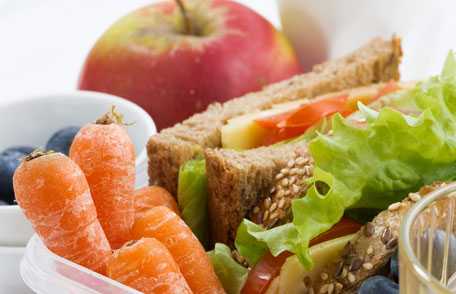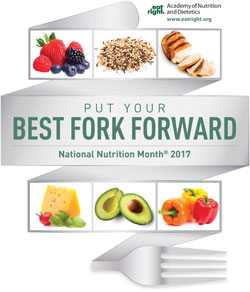Put Your Best Fork Forward!
 Eat more fruits and vegetables.
Eat more fruits and vegetables.
March is National Nutrition Month and this year’s theme is “Put Your Best Fork Forward!” Part of leading a healthy life means eating a healthy diet and being physically active.
A recent CDC study highlights when, where, and how U.S. adults and children are eating a healthy diet. Those who are not getting enough fruits and veggies can take small steps towards meeting recommended amounts, including adding more fruit to your usual breakfast routine or adding vegetables to your meals.
Eating a diet rich in fruits and vegetables can help reduce the risk of many leading causes of illness and death, add important nutrients to your diet, and help with weight control.

“Put Your Best Fork Forward”
Are you getting enough fruits and vegetables every day? The amount of fruits and vegetables you should eat varies by age, gender, and activity level. Click on the links below to learn how many fruits and vegetables you need every day.

Add fruit to your breakfast.
The recent study shows that adults get most of their fruit during breakfast and snacking whether they eat recommended amounts or not. Those who are not getting enough could aim to add more at breakfast or through snacks such as eating a small apple or banana. On the other hand, children tend to eat fruit throughout the day. Children who need more could add extra fruit to their breakfast, lunch, or snack routines.
Dinnertime tends to be when adults and children eat most of their vegetables. However, for those who are not eating enough vegetables, try adding vegetables to your lunchtime salad or sandwich (e.g., tomato slices or baby carrots) or mixing them into what you are having for dinner (e.g., adding broccoli into your pasta).
Visit USDA’s ChooseMyPlate to learn more about the small steps you can take towards a healthier eating style.
You can also take a look at the latest edition of the U.S. Dietary Guidelines for Americans. These recommendations were developed to provide a better understanding of food and nutrition so that you can make informed decisions about healthy foods and drinks. It also gives you the flexibility to make healthier food choices that are right for you and your family. The 2015-2020 Dietary Guidelines for Americans is available at dietaryguidelines.gov.
CDC’s Division of Nutrition, Physical Activity, and Obesity supports Americans’ journey to good health by working in the following settings:
-
Early childcare education centers
We work in states to help early care and education providers meet national nutrition standards. -
Schools
We partner with national partners to increase privately donated salad bars in schools. -
Worksites
We offer assistance on how to adopt and implement healthy food service [3.34 MB] guidelines in worksites. -
Community food retail stores
Full-service grocery stores, farmers markets, and other retailers that sell healthier foods and beverages such as fruits, vegetables, whole grains, and low-fat dairy are not found in every neighborhood. We work with states and communities to increase healthier food options in these community retail settings.
Nutrition Resources
- Page last reviewed: March 1, 2017
- Page last updated: March 1, 2017
- Content source:
- National Center for Chronic Disease Prevention and Health Promotion, Division of Nutrition, Physical Activity, and Obesity
- Page maintained by: Office of the Associate Director for Communication, Digital Media Branch, Division of Public Affairs




 ShareCompartir
ShareCompartir